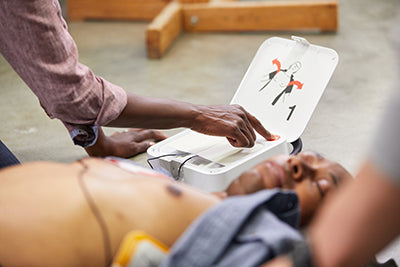Can you Afford to not have an AED On-Site
In Canada, cardiac emergencies can happen anywhere, at any time. While the primary concern during such events is always human life, organizations must also consider the significant financial implications of not having an Automated External Defibrillator (AED) readily available. Beyond the immeasurable cost of a preventable tragedy, there are concrete financial risks that Canadian businesses, institutions, and public spaces face when they operate without these life-saving devices on site.
The Reality of Cardiac Emergencies in Canada
Each year, approximately 50,000 Canadians experience sudden cardiac arrest outside of hospital settings. Without immediate intervention, the survival rate drops by 7-10% for every minute that passes. When an AED is used within the first few minutes, survival rates can increase from less than 10% to over 70%.
While many Canadians know to search for an "AED near me" during an emergency, the reality is that many locations still lack these critical devices. This gap in emergency preparedness carries substantial financial implications.

Direct Financial Costs of Not Having an AED
Legal Liability and Lawsuits
In Canada, while there is no federal legislation mandating AEDs in all public spaces, the legal landscape is evolving. Several provinces have enacted or are considering legislation requiring AEDs in certain locations. More importantly, the standard of care expected from organizations is rising.
When a cardiac arrest occurs at a location without an AED, and the victim suffers severe brain damage or dies, the organization could face:
- Negligence claims
- Wrongful death lawsuits
- Failure to meet the expected standard of care allegations
These legal proceedings can result in settlements or judgments ranging from hundreds of thousands to millions of dollars, far exceeding the AED price of $2,500 for a standard unit.
Insurance Premium Increases
Following a cardiac emergency without proper equipment, organizations may face:
- Higher liability insurance premiums
- Additional risk assessments
- Potential coverage limitations
These increased costs continue for years after the incident, creating an ongoing financial burden that significantly outweighs the initial AED cost.
Regulatory Fines and Penalties
As provincial regulations evolve, organizations may face fines for non-compliance with AED requirements. These penalties vary by jurisdiction but can include:
- Direct monetary fines
- Mandatory investments in safety equipment
- Required safety audits at the organization's expense
Indirect Financial Impacts
Business Interruption
A cardiac emergency on site without proper response capability can lead to:
- Temporary business closure during investigation
- Lost productivity and revenue
- Staff emotional trauma and absenteeism
The Canadian Occupational Health and Safety regulations may require incident investigations that disrupt normal operations, further increasing costs.
Reputational Damage
The reputational impact of a preventable death can be devastating:
- Negative media coverage
- Public perception of negligence
- Customer and client trust erosion
- Difficulty attracting and retaining employees
This damage can persist for years, with measurable impacts on revenue and market position. Studies have shown that businesses can lose up to 20% of their customer base following significant negative publicity about safety issues.
Employee Morale and Productivity
When employees witness a colleague's cardiac emergency without proper emergency response equipment:
- Workplace morale typically plummets
- Productivity decreases
- Staff turnover increases
- Stress-related absenteeism rises
These factors create substantial hidden costs that affect the organization's bottom line for months or years after the incident.
AED vs. CPR: The Financial Equation
While CPR training is essential, relying solely on CPR without an AED significantly reduces survival chances during cardiac arrest. From a financial perspective:
- CPR alone provides approximately 5-10% chance of survival
- CPR plus AED increases survival rates of greater than 70%
This difference translates to dramatically different financial outcomes in terms of liability, insurance claims, and potential litigation. The combination of CPR with AED use represents the gold standard in cardiac emergency response.

https://aed.ca/products/stryker-physio-cr2-semi-auto-english-wifi
Understanding AED Requirements in Canada
While specific AED requirements vary by province, organizations should be aware of emerging standards:
- Ontario's Chase McEachern Act encourages AED installation and provides liability protection for users
- Manitoba requires AEDs in high-traffic public places including gyms and community centers
- Several municipalities have enacted bylaws requiring AEDs in specific locations
Organizations that proactively meet these requirements not only reduce liability but also position themselves favorably should an emergency occur.
The Investment Perspective: AED Price vs. Risk Mitigation
When viewed as a risk management investment, an AED offers exceptional return:
Initial Investment
- Portable AED units: $1,899-$2,500
- AED training: $299
- Cabinet and signage: $$300
Annual Maintenance
- Electrode pad replacement (every 2-5 years): $100-$300
- Battery replacement (every 4-5 years): $200-$500
- System checks: Minimal internal cost
Compared to the potential financial exposure from a single incident, which can easily reach millions of dollars, the return on investment is clear. Providers like AED.ca offer various purchase options that make acquiring these devices more financially accessible.
Case Study: The Cost of Delay
In 2018, a major Canadian fitness facility faced a $5 million lawsuit after a member experienced cardiac arrest and suffered permanent brain damage. The facility had been considering installing AEDs but delayed the decision due to budget constraints. The court found the facility partially liable for not meeting the standard of care expected in the industry.
The settlement amount far exceeded what would have been a $10,000 investment in AEDs for all their locations. Additionally, their insurance premiums increased by 35% following the incident.
How to Use an AED: Simplicity Reduces Financial Risk
Modern AEDs are designed to be user-friendly, with clear voice prompts guiding users through each step. This accessibility means:
- No medical background is required to operate them effectively
- The devices themselves determine if a shock is needed
- The risk of improper use is minimal
This simplicity reduces liability concerns about improper use, making AEDs a relatively low-risk safety investment compared to many other emergency response tools.
The Path Forward: Mitigating Financial Risk
Organizations looking to mitigate the financial risks of not having an AED should:
- Conduct a risk assessment of their specific location and activities
- Research AED options from reputable providers like AED.ca
- Implement an AED program including proper placement, signage, and registration
- Provide staff training on how to use an AED in conjunction with CPR
- Develop clear emergency response protocols integrating AED use
- Maintain devices properly with regular inspections and updates

https://aed.ca/products/zoll-aed-3
Conclusion
The financial risks of not having an AED on site extend far beyond the initial device purchase price. When calculating the true cost-benefit analysis, organizations must consider potential liability, insurance implications, business interruption costs, and reputational damage.
With AED price points becoming increasingly accessible and options available from providers like AED.ca, the financial argument for installation is compelling. Combined with the primary benefit—potentially saving lives—the decision to install AEDs represents both sound financial management and responsible organizational leadership.
In today's environment, where public expectations and legal standards continue to evolve, the question isn't whether organizations can afford to install AEDs, but rather: Can they afford not to?






